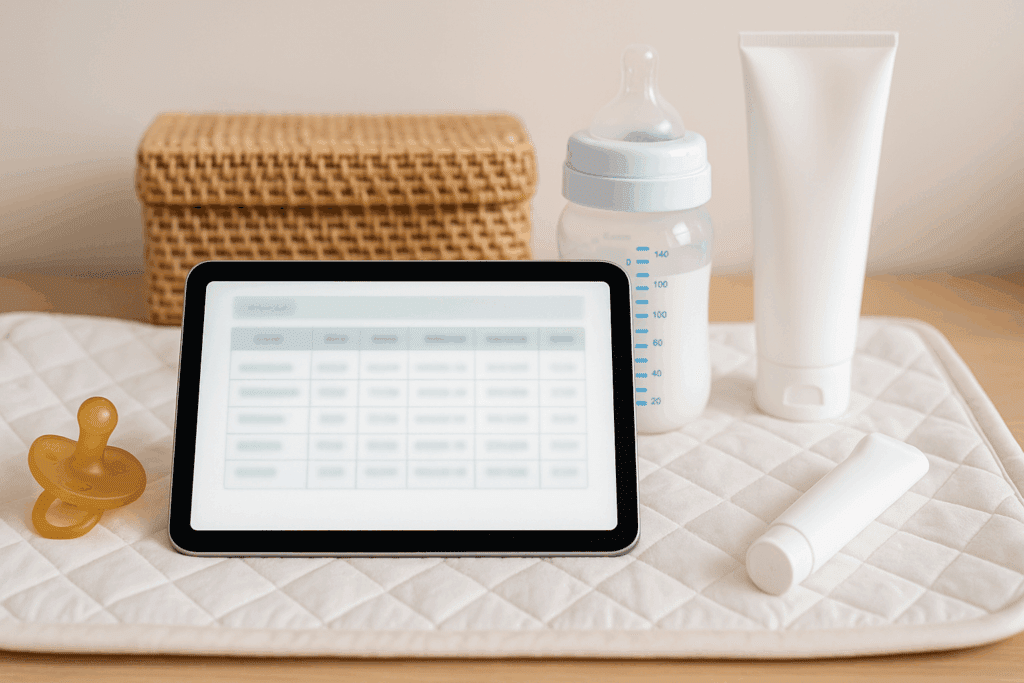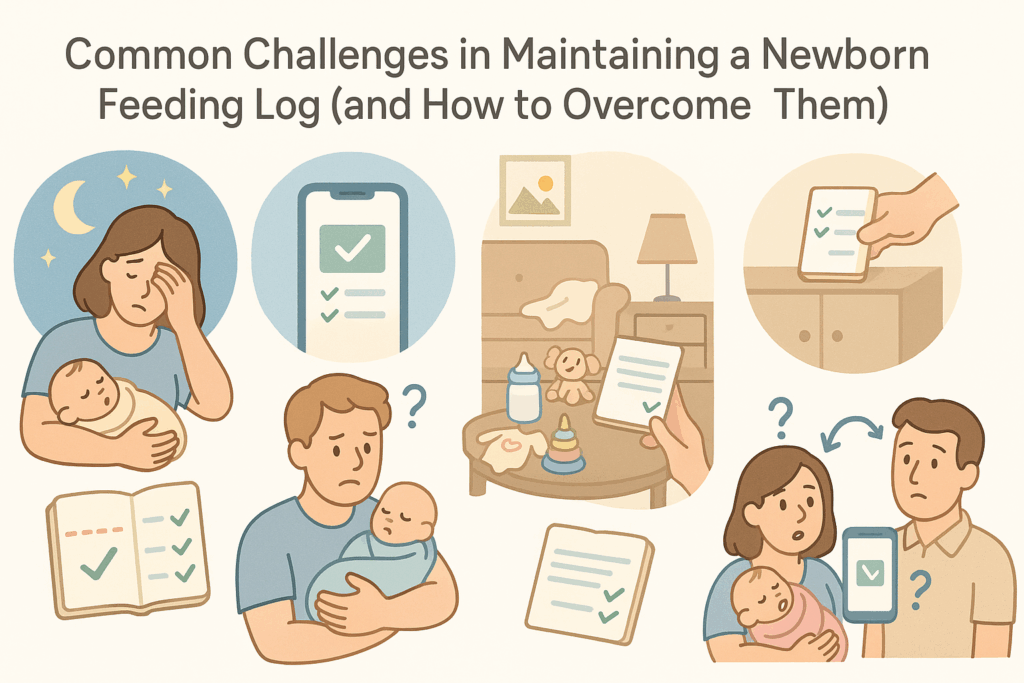Welcoming a newborn into the world is a momentous event filled with joy, learning, and a multitude of decisions that impact a child’s health. One of the most foundational aspects of early childhood care is nutrition. Parents and caregivers are often advised to closely monitor feeding habits in order to support healthy development. Among the most effective and research-backed methods to ensure appropriate nourishment and track dietary patterns is maintaining an infant feeding log. This tool not only promotes routine but also supports early detection of nutritional concerns and ensures that a child’s growth milestones are met on time. An infant feeding log is a practical, evidence-based strategy that blends caregiving with measurable health outcomes—a synergy that makes a world of difference in a child’s formative years.
You may also like: Essential Milestones in Baby Led Weaning: A Proven Guide to Nurturing Healthy Eating Habits

Understanding the Purpose and Benefits of an Infant Feeding Log
At its core, an infant feeding log is a detailed record that tracks every feeding event in a newborn’s day. This includes the type of feeding (breastfeeding, formula, or solid foods as the child grows), quantity consumed, time of feeding, and even additional notes about the infant’s behavior or digestion post-feeding. While it might initially seem like an extra task for already-busy parents, this log quickly becomes an indispensable tool. For instance, when an infant experiences digestive discomfort, inconsistent weight gain, or changes in sleep patterns, the log provides a valuable timeline to help identify patterns or triggers. It facilitates informed conversations with pediatricians and nutritionists, offering them concrete data rather than vague recollections.
Moreover, establishing a feeding log promotes consistency. Infants thrive on routine, and the simple act of logging helps caregivers stick to a feeding schedule that supports regularity in digestion, sleep, and behavior. As infants grow, the log can help transition their diets in a developmentally appropriate way, such as introducing purees, finger foods, and eventually table foods at the right intervals. Another overlooked benefit is that shared caregiving becomes smoother. Whether a child is under the care of a parent, grandparent, or babysitter, the feeding log ensures continuity and accuracy in nutrition management.

Why an Accurate Newborn Feeding Log Matters from Day One
During the first few weeks of life, infants undergo rapid physical and neurological changes. An accurate newborn feeding log plays a pivotal role in ensuring that babies are not only fed adequately but also absorbing nutrients effectively. At this stage, even minor deviations from optimal intake can have pronounced effects on energy levels, weight, and immune function. Breastfed babies, for example, often feed more frequently than formula-fed infants and might not consume the same volume per session. Without a log, it’s easy to underestimate or miscalculate how often and how much a baby is eating.
Additionally, newborns often experience growth spurts that increase feeding frequency. By reviewing the feeding log, parents can spot these shifts and respond appropriately, either by offering more frequent nursing or increasing formula amounts. Moreover, in cases of health concerns such as colic, reflux, or suspected allergies, an accurate record of feeding times, types of food, and infant reactions becomes essential. Medical professionals rely on this information to make diagnostic and treatment decisions. A newborn feeding log is not just a journal; it is a dynamic diagnostic instrument that informs the clinical care pathway.
The Role of an Infant Feeding Log in Reaching Growth Milestones
Growth milestones in infancy are not just a marker of weight and height but encompass motor development, sensory acuity, and cognitive progress. Nutrition is deeply entwined with each of these domains, making an infant feeding log a central element in developmental tracking. The log allows for continuous evaluation of feeding adequacy, especially during crucial transitions, such as moving from exclusive breastfeeding or formula to the inclusion of solid foods.
The timing and sequence of introducing complementary foods matter significantly. Introducing solids too early can compromise iron intake, while introducing them too late can hinder oral-motor development. A log that records not only what was fed but also the infant’s response to new textures and flavors provides a comprehensive overview of readiness and adaptation. When concerns arise, such as slow weight gain or feeding refusal, a well-maintained log can serve as a clinical narrative, reducing the need for guesswork and enabling targeted interventions.
In households where infants are at risk for nutrient deficiencies or have family histories of food sensitivities, the feeding log becomes an essential screening tool. It encourages proactive management of feeding schedules and dietary variety. Ultimately, reaching growth milestones is about aligning nutrition with physiological demands, and the feeding log ensures that no step in this alignment is overlooked.

How to Structure an Effective Infant Feeding Log for Daily Use
To be effective, an infant feeding log must be designed for both thoroughness and ease of use. The most basic elements include date, time of feeding, type of feeding (breast, bottle, solid), amount taken (when measurable), duration (especially for nursing), and infant behavior during and after feeding. Notes on stool frequency and consistency, burping, and signs of discomfort or allergy also enrich the utility of the log. For infants transitioning to solids, including the type of food offered, texture, and whether it was accepted or refused can offer insights into developmental readiness and preference.
Digital tools such as mobile apps and spreadsheets have become increasingly popular for tracking feedings, offering features like automated reminders and growth charts. However, some caregivers still prefer traditional pen-and-paper methods for their simplicity and accessibility. Regardless of format, consistency in logging is key. Logs should be updated in real-time to ensure accuracy, and reviewed regularly—ideally weekly—to track progress and spot trends. Collaboration among caregivers is also crucial; everyone involved in infant care should be trained on how to log data accurately and encouraged to add qualitative notes that might explain variations in feeding patterns.

Common Challenges in Maintaining a Newborn Feeding Log (and How to Overcome Them)
Despite the clear benefits, maintaining a newborn feeding log comes with its own set of challenges. The most common barrier is time. Between diaper changes, sleep deprivation, and countless other tasks, logging every feed can feel overwhelming. One solution is to use voice-to-text features on smartphones or quick checklists that can be filled in within seconds. For those who prefer analog methods, keeping a small notebook in multiple areas of the house—such as near the crib or feeding chair—can eliminate the need to search for the logbook during hectic moments.
Another common issue is inconsistent participation among caregivers. If only one person is maintaining the log, gaps in information can occur, leading to incomplete data. Establishing shared access to digital logs or creating a visible command center in the home—such as a whiteboard or bulletin board with daily feeding goals—can help. Caregivers should also debrief each other during handovers to ensure continuity. Lastly, some parents become anxious if the log shows irregularities or deviations from standard feeding recommendations. It’s essential to interpret the log as a guide, not a judgment. Flexibility is part of infant care, and a log should support decisions, not induce stress.

Using an Infant Feeding Log to Identify Allergies, Intolerances, and Digestive Issues
One of the most valuable yet underappreciated uses of an infant feeding log is identifying potential allergies and intolerances. Symptoms such as rash, vomiting, diarrhea, or unusual fussiness after feedings can often be attributed to dietary components. By recording exactly what was fed, when, and how the infant responded, caregivers can establish patterns that aid in diagnosis. For breastfed infants, even maternal diet can be tracked alongside feeding responses to identify correlations.
In formula-fed babies, changes in brand or preparation method can also lead to digestive distress. A well-documented feeding log helps isolate the variable causing the issue, whether it’s lactose sensitivity, protein allergy, or simply overfeeding. Pediatricians frequently rely on these logs to recommend elimination diets or trial formulas. For babies starting solids, introducing one new food every three days and logging the results is a clinically accepted strategy for allergy screening. It ensures that any reaction can be traced back to a single food, minimizing the guesswork involved in managing adverse reactions.
Additionally, digestive concerns such as gastroesophageal reflux, constipation, or feeding aversion can be assessed through trends in the feeding log. If a baby consistently refuses feedings at certain times, feeds for too short a duration, or shows signs of discomfort, the log provides objective evidence that supports further medical evaluation or feeding therapy referrals.

Supporting Breastfeeding Success Through Detailed Log Tracking
Breastfeeding, though natural, often comes with a learning curve for both mother and baby. An infant feeding log can be a critical tool for supporting breastfeeding success. It helps mothers monitor the frequency and duration of nursing sessions, assess which breast was used last, and note changes in latch quality or infant behavior. These details are particularly useful during the early postpartum weeks, when milk supply is still stabilizing and proper stimulation through regular feeding is vital.
Tracking output (wet and dirty diapers) in conjunction with feeding can also reassure parents that the infant is getting enough milk, even when exact quantities cannot be measured. For mothers experiencing challenges such as low supply, oversupply, or mastitis, logs can provide information that aids lactation consultants in creating tailored intervention plans. The log becomes not just a record, but a reflection of the breastfeeding journey, highlighting progress, setbacks, and strategies that work.
Moreover, breastfeeding mothers often need to manage pumping schedules, particularly if they are returning to work or sharing feeding duties. A comprehensive log that includes pumping sessions, output volume, and storage information helps manage supply and demand effectively. It also ensures that caregivers feeding expressed milk have clear guidance on when and how much to offer.
Incorporating Developmental Cues into Your Infant Feeding Log
Infants communicate readiness, hunger, and satiety through a complex system of cues. Integrating these cues into the feeding log enhances its utility and reflects a responsive feeding approach. For example, noting whether the infant rooted, sucked on hands, or turned their head before feeding helps identify hunger patterns that may shift over time. Similarly, documenting signs of satiety such as turning away, losing interest, or falling asleep mid-feed can help prevent overfeeding and support self-regulation.
Cues related to developmental readiness for solids—such as sitting unsupported, mouthing objects, and showing interest in food—can also be logged. These observations provide context for introducing new textures and flavors in a way that respects the infant’s individual pace. Behavioral cues during and after feeding, such as gagging, spitting, or excitement, also add layers of understanding that contribute to effective dietary planning.
These developmental cues also support broader caregiving goals. A feeding log that captures behavioral context fosters mindful parenting and enhances bonding. Rather than viewing the log as a sterile record, it becomes a narrative of the child’s growth, preferences, and evolving relationship with food. This emotional and developmental depth transforms the log from a clinical tool to a holistic caregiving ally.

Transitioning from Newborn Feeding Log to Toddler Nutrition Tracking
As infants grow into toddlers, their nutritional needs expand and diversify. The structure and focus of the feeding log should evolve accordingly. While early logs emphasize frequency and intake, toddler logs are better suited to tracking dietary variety, portion sizes, and mealtime behaviors. At this stage, many children begin family meals and are introduced to a wider array of textures and nutrients. Logging this transition ensures that essential nutrients such as iron, calcium, and vitamin D are adequately represented in the diet.
The toddler years are also prime time for establishing healthy eating habits and identifying early signs of picky eating or sensory aversions. A feeding log can highlight preferences, tolerances, and problematic behaviors, such as food refusal or grazing throughout the day. Additionally, toddlers may experience growth spurts or plateaus that influence appetite; feeding logs provide insights into whether shifts in eating patterns are developmentally appropriate or cause for concern.
Incorporating mealtime context—such as where the child ate, who was present, and how the food was served—can reveal environmental factors affecting intake. For example, children may eat more in social settings or struggle with distractions. Such nuanced information supports interventions that go beyond nutrient intake and into the realm of behavioral and developmental support, further enhancing the value of long-term nutrition tracking.
Frequently Asked Questions: Advanced Insights into Infant Feeding Logs for Modern Caregivers
How can I tailor an infant feeding log to track both nutrition and emotional bonding moments?
Many parents focus solely on intake and timing in an infant feeding log, but integrating emotional context can offer a richer narrative of the feeding experience. For example, noting if a feeding occurred during a quiet bonding moment or a rushed environment can provide clues about how atmosphere affects intake and satisfaction. Adding a simple mood column—for both baby and caregiver—may illuminate patterns related to stress, comfort, and feeding effectiveness. Over time, you may find that your baby feeds more effectively during calm, skin-to-skin sessions or in dimly lit rooms. Emotional tracking within the log also supports maternal mental health monitoring, offering early detection of postpartum anxiety or depression when trends of overwhelming fatigue or distress appear consistently during feedings.
What features should I look for in a digital newborn feeding log app to enhance usability and compliance?
Choosing a newborn feeding log app involves more than basic time stamps. Look for apps that offer customizable data fields, such as nursing side, bottle type, solid food introduction notes, and diaper tracking, all of which support holistic care. Automatic syncing across devices is critical in households with multiple caregivers to ensure real-time updates and avoid duplications. Some advanced apps now include AI-driven insights that analyze feeding patterns against developmental benchmarks, alerting you to potential anomalies before they become concerns. Integration with pediatric growth chart data is another valuable feature, helping parents correlate nutrition logs with height and weight milestones in a medically meaningful way. Ideally, the app should allow exporting data into PDF or CSV formats for easy sharing with healthcare providers.
Can an infant feeding log support childcare transitions, such as returning to work or hiring a nanny?
Absolutely. A well-maintained infant feeding log functions as a reliable handoff document between primary and secondary caregivers. It ensures continuity in feeding routines and provides objective data on infant preferences and needs. Before returning to work, reviewing your log can help you identify optimal pumping times, how much milk your infant consumes during the day, and the average intervals between feeds. When onboarding a new nanny or daycare provider, presenting a structured feeding log reduces confusion, reinforces routines, and gives caregivers confidence in their roles. Over time, shared logging can also highlight discrepancies or emerging feeding concerns that may not surface in brief daily updates.
How do cultural feeding practices influence the structure of an infant feeding log?
Cultural norms deeply influence feeding schedules, preferred foods, and the interpretation of hunger and satiety cues. For example, some families emphasize extended breastfeeding, while others introduce herbal teas or broths early in infancy. In such cases, the infant feeding log should be adapted to include culturally relevant data points, such as types of supplemental liquids or ceremonial feeding times. Including a column for culturally significant foods or rituals helps pediatricians understand dietary influences without imposing unnecessary interventions. Moreover, reflecting these values within the log fosters a sense of respect and inclusivity, encouraging more consistent and meaningful use across diverse family settings.
How can an infant feeding log help identify silent feeding challenges, such as tongue-tie or poor latch?
Some feeding difficulties don’t manifest through overt fussiness or refusal but instead appear subtly in patterns over time. An infant feeding log can spotlight these issues by revealing long feeding durations with low milk transfer, excessive gassiness post-feed, or multiple short, inefficient sessions. When reviewed by a lactation consultant, these logs may suggest physical barriers like tongue-tie, lip-tie, or an unproductive latch that require clinical assessment. Infants with such conditions often compensate by feeding more frequently yet gaining weight slowly, a pattern that can be hidden without consistent tracking. The data within the log helps professionals diagnose these silent challenges earlier, reducing stress for both baby and caregiver.
Why is it beneficial to continue using an infant feeding log during travel or vacation periods?
Travel disrupts routines, introduces new environments, and often brings changes in caregivers—all of which can affect an infant’s feeding habits. Maintaining a consistent infant feeding log during these times provides a stable point of reference. If an infant refuses feedings or displays digestive issues, the log can help determine whether the problem is due to environmental stress, dietary shifts, or time zone differences. Additionally, the log can assist in adapting feeding schedules to local time zones without compromising nutritional adequacy. For breastfeeding mothers, tracking output during travel is also vital for maintaining supply, particularly when nursing frequency or pumping times are affected.
What are the long-term developmental benefits of maintaining a consistent newborn feeding log?
Beyond immediate nutritional management, a newborn feeding log lays the groundwork for early literacy in nutrition and health tracking. Children whose caregivers model organized, attentive approaches to food and care often grow up with stronger self-regulation around eating. Parents who track diligently may be more likely to introduce balanced meals, recognize signs of food sensitivities earlier, and foster routines that enhance sleep and cognitive development. Longitudinally, these children may face fewer struggles with obesity or feeding disorders. Furthermore, feeding logs can serve as historical documents when assessing developmental delays or chronic conditions later in childhood, offering retrospective insights that enrich diagnostic accuracy.
Exploring Advanced Use Cases: How to Integrate Biomarkers into an Infant Feeding Log
For medically fragile infants or those in neonatal care, some parents choose to add biomarker data to their infant feeding log, such as glucose levels, bilirubin readings, or supplementation schedules. This integration allows for more nuanced tracking and supports collaborative care across specialists. If a baby is on fortified breast milk or receiving additional vitamins, logging the specific timing and dosing of these elements can help monitor for adverse reactions or effectiveness. Parents managing rare conditions, such as metabolic disorders or failure to thrive, often benefit from such detailed data, which transforms a basic newborn feeding log into a medically robust record. Always consult with a healthcare provider to determine which biomarkers are relevant and how frequently they should be documented.
Can an infant feeding log help detect patterns in sleep disturbances or behavioral shifts?
Many sleep regressions and behavioral shifts in infants are linked to underlying nutritional or digestive issues. By cross-referencing feeding times, types of intake, and post-feed behavior with nighttime waking patterns, a caregiver may identify patterns that suggest overfeeding, underfeeding, or intolerance to certain foods. For instance, a log may reveal that a baby wakes frequently at night after consuming a certain brand of formula or new solid food. These insights support more strategic adjustments, such as changing feeding windows or altering diet composition. Over time, aligning the feeding log with sleep tracking tools can promote better rest for both infants and caregivers, reinforcing healthier developmental rhythms.
Future-Proofing Infant Nutrition: The Role of AI in Enhancing the Infant Feeding Log
As technology advances, artificial intelligence is beginning to transform the way we use an infant feeding log. Emerging platforms can now analyze feeding data to predict hunger windows, detect deviations from personalized growth curves, and even generate alerts for potential health issues. In the near future, smart bottles and connected breastfeeding monitors may automatically populate feeding logs with real-time data, eliminating manual entry. This automation could be especially valuable for parents juggling multiple responsibilities, enhancing both compliance and accuracy. While human observation remains irreplaceable, AI-enhanced feeding logs hold the potential to democratize early health analytics and elevate nutritional care to unprecedented precision.
Supporting Digestive Health and Nutrient Absorption Through an Infant Feeding Log
Though typically used for tracking intake, an infant feeding log can also be a powerful tool for assessing how well nutrients are absorbed. By logging signs such as stool consistency, frequency, and color in tandem with feeding types, caregivers can detect issues like malabsorption, constipation, or diarrhea linked to dietary changes. If a child is on iron supplementation or high-fat feeds, documenting corresponding digestive responses provides context for evaluating effectiveness. Additionally, when introducing probiotics or adjusting fiber content in older infants, the log can measure changes in bowel regularity and comfort. In this way, the infant feeding log evolves from a reactive record into a proactive guide for optimizing digestion and nutrient uptake.
Conclusion: Building Healthy Foundations with an Infant Feeding Log
Creating and maintaining an accurate infant feeding log is far more than a routine task—it is a foundational practice that supports healthy growth, early detection of challenges, and confident caregiving. By documenting feeding behaviors, nutritional intake, and developmental cues, parents and caregivers gain actionable insights that translate into more responsive, personalized care. Whether navigating the complexities of breastfeeding, managing food allergies, or ensuring milestone achievement, the log serves as both a compass and a chronicle.
The infant feeding log fosters collaboration among caregivers and healthcare professionals, ensures continuity in nutrition management, and promotes the kind of reflective caregiving that underpins healthy physical and emotional development. As children grow from newborns into toddlers, the log evolves alongside them, offering a dynamic record of nutritional history and developmental progress. In a world filled with parenting advice and shifting guidelines, the feeding log remains a steadfast, evidence-informed tool that empowers families to make informed decisions with clarity and confidence. For any caregiver committed to nurturing a child’s well-being from the very beginning, the practice of keeping an infant feeding log is not just advisable—it is essential.
Further Reading:
DEVELOPMENTAL STAGES IN
INFANT AND TODDLER FEEDING
Baby Feeding and Nutrition Guide | How much formula is right for a newborn



